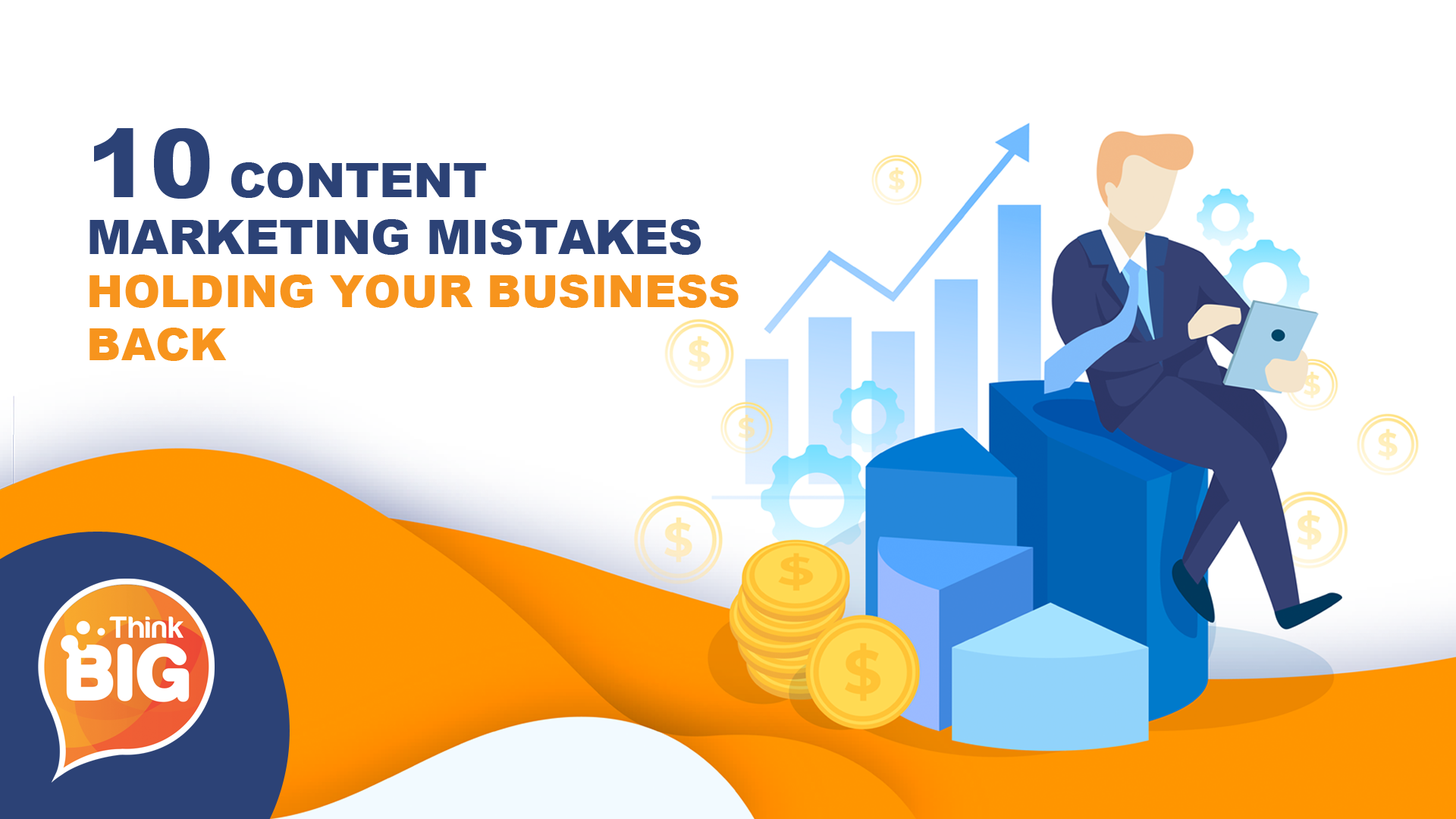
1. Never Setting Goals
The moment a small business owner decides that they should start implementing a content marketing strategy, they’ll probably want to start producing content immediately.
But savvy business owners understand that diving in without a plan is a recipe for disaster in the world of digital marketing.
Why? Because the rules are always changing.
The digital marketing ecosystem is a constantly shifting landscape, and assuming that you know what’s going to happen tomorrow is the fastest way to stunt your growth today.
The consumer’s attention goes to a different platform, email marketing suddenly stops being as effective, etc.
Anyone that’s been a member of the content marketing community will tell you that the rules of engagement are never set in stone.
And the reality of the situation is that you’ll never be able to anticipate all of these changes. What you can do is establish a strong foundation with clear, actionable, and measurable goals.
After all, you wouldn’t expect an archer to hit their target if they didn’t know what they were aiming at, right?

2. Never Developing A Brand Voice
Listen, we get it.
‘Branding’ has been used as a buzzword for so long that, at this point, it feels like it’s started losing its meaning.
But in the context of content marketing, brand is actually pretty straightforward.
As far as your ‘brand voice’ is concerned, here’s the easy way to think about it: your brand voice is the unique way that you communicate directly with your audience.
Unique is the key term here, in the sense that your content should be a reflection of insights that audiences can’t find anywhere else.
When audiences are reading your content, they’re not just looking for the right information. They’re looking for an experience that’s as educational as it is interesting.
Of course, the real question is how on earth you manage to pull that off.
There are a few schools of thought here, but the core principles are pretty consistent.
Right off the bat, you can’t be afraid to get personal with your audience. If they wanted to read a technical paper, they wouldn’t be reading your blog right now.
Resist the urge to use too many industry terms. There’s no use in ‘sounding smart’ if your audience walks away from your content confused or bored.
And make the effort to speak directly to your readers. You want to offer valuable information, but you also want to be sure your readers are relating to it.

3. No Mobile-Friendly Content
This might seem like a rookie mistake, but there are plenty of veteran small business owners who are still struggling with this.
Now, there’s nothing wrong with crafting content for desktop users. In fact, if you have data showing that your audience mainly reads your content from a desktop or laptop, go ahead and craft away.
But more often than not, businesses are going to be neglecting a massive portion of their audience by not making their content mobile-friendly.
In 2017, a study found that mobile device traffic was up from 57% to 63%.
That’s right, mobile traffic is now outpacing desktop traffic! Which means that you might have a poor user experience (UX) for as much as 63% of your audience.
Like most things in the world of UX, the key is to make things accessible to everyone.
At no point should you ignore any of your audience, especially when the process of improving their experience is relatively simple.
And let’s not forget about the fact that Google themselves have basically made it impossible to ignore mobile traffic.
If you’re not sure how mobile-friendly your site is, Google has a free tool you can use to test out how well your site performs.

4. Poor Promotion
Creating content is important, clearly. But that content isn’t going to do you much good if no one reads it.
In the world of content marketing, first-timers tend to fall into one of two categories.
Either they focus too heavily on promotion and don’t worry about the content, or they spend all their time focused on the content without worrying about promotion at all.
We’ll get to the dangers of quantity over quality later. For now, it’s important that you understand just how important properly promoting your content is.
There’s a saying in the digital marketing community: if Google doesn’t know who you are, no one does.
And while it might be a bit on the nose, there’s no getting around the fact that you can’t expect your influence to grow without traffic.
Which brings us to the dreaded “how do I increase my traffic consistently?” question.
If it’s in your budget, we highly recommend you look into social media ads. Organic traffic can certainly help you, but the ROI on something like Facebook Ads is just too high to ignore.
Of course, you’ll want to make sure you have a strong understanding of your audience before you start spending any money.
Take the time to develop buyer personas and continue to tweak them as you learn more about what makes your audience tick.

5. Focusing On Quantity Over Quality
For every business owner that doesn’t spend much time on promotion, there’s another business owner that doesn’t care too much about the quality of their content.
And to a certain extent, it makes sense why they wouldn’t.
Your typical business owner looking at the digital marketing ecosystem for the first time is going to see traffic as the key metric to focus on.
And while traffic certainly matters, it’s just the tip of the iceberg.
What you’re really after here is meaningful engagement. Or to be more specific, conversions.
Whether you’re trying to sell someone a backpack or convince a reader to sign up for your email list, conversions are the metric that determines whether or not your marketing efforts are moving people from a ‘maybe’ to a ‘yes’.
And that metric is directly tied to the level of engagement consumers are willing to have with your business.
Getting 1000 people to visit a site isn’t impressive — getting 1000 people to buy from a site is impressive.
So, you’ve got their attention. Now what?
If they get to your site and they don’t like what they see, then what was the point of getting them there?
You need to care about traffic because you can’t have engagement without attention. But it doesn’t end there. You need engaging, high-quality content and copy to convince people your business is worth their time and money.

6. No Calls To Action
This is easily one of the most frustrating issues to see on someone’s site.
They’ve taken the time to create high-quality content and they’ve even managed to handle the promotion for that content pretty well.
Everything looks great except — they don’t have any compelling calls to action (CTA).
All this talk about marketing might make it sound overly complex, but the goal is always the same: move people from the marketing funnel into the sales funnel.
But we can’t just expect people to move themselves there. After reading through your content, people need some clear direction on the next steps they should take.
If they just finished reading your article on outdoor backpacks, don’t just say “check us out!”
The best calls to action give readers a simple instruction that’s directly related to the content they just read.

7. Not Value-Driven Content
If we had to point to one mistake that could cripple your content marketing efforts single-handedly, it would have to be this.
There’s no easy way to put it: when you don’t offer value in your content, your audience is eventually going to lose interest.
We’ve all been there. You’re looking for an answer to a question on Google, when you suddenly find a link that seems like it’s going to give you exactly what you were searching for.
But once you clicked on the link, you quickly realized that the page cares more about getting your traffic and driving a conversion than it does about giving you a helpful answer.
The ecommerce world is filled with pages like these. They pretend to offer value, but they end up being transparent attempts at self-promotion.
The site doesn’t care about you, they care about your money.
And when a consumer can sense that a site doesn’t care about them, there’s a good chance that consumer isn’t going to care about the site.
Of course, all this brings up an interesting question. How on earth can you be sure that your content is going to be valuable to your audience?
Well, you need to create content that treats problem solving as the purpose.
Most of the time, articles that feel gimmicky weren’t built with consumer pain points in mind.
Which means that if you want your content to feel authentic and natural, it needs to offer answers to the questions readers have.
Use buyer personas, competitor research and industry metrics to determine what burning questions your audience needs answered.
Make the solution the priority and before you know it, your content will develop a reputation for being genuinely helpful.

8. Misunderstanding SEO
Over the last few years, social media marketing has become one of the most powerful tools in a small business owner’s arsenal.
And it’s no surprise why. Low barriers to entry, solid ROI, and plenty of attention on these platforms makes them an easy sell.
But lately, more and more marketing ‘experts’ have started to claim that the rise of influencer and social media marketing means that SEO is either dying or already dead.
Let’s get one thing straight: SEO is many things, but it’s not dead.
The fundamental misunderstanding that people have here is they view SEO and social as polar opposites.
In reality, these are two sides of the same marketing coin. And if you want to experience success in the digital marketing space, you’ll need to spend time on both.
While social is fantastic as a way to drive engagement, it’s not going to do you a ton of favors when it comes to getting your content ranking on Google.
If Google spoke a language, it would be SEO. And ignoring things like long tail keywords means that your content won’t be able to communicate to Google the way you’d want it to.
Traffic is the gateway to engagement and engagement is the gateway to conversions.
In other words, the moment you give up on the potential Google search traffic you’d get from a well executed SEO strategy, you’ve flushed quite a bit of money down the drain.

9. Poor User Experience
This might seem like a ‘quality of life’ issue, but make no mistake. An annoying user experience (UX) will scare away even the most interested readers.
Why? Because it’s awful.
If they can’t navigate the site easily, they’re gone.
If the pages take forever to load, they’re gone.
If your presentation feels cheap or gimmicky in any way — you get the idea.
When it comes to content marketing, you have to be aware of the fact that presentation is just as important as substance.
The moment you introduce any friction between your readers and your content, you run the risk of losing them.
Take the time to ensure that your site runs smoothly, that pages load quickly and that the overall presentation of your site reflects the time and effort you’ve put into crafting the content.

10. No Engagement With Audience
So, you’ve created a dynamite piece of content that you’re sure your audience will love.
Great! But don’t think that your job is over.
In fact, it’s just getting started.
The key to a successful content marketing strategy is not just having great content. You need to take those audience members and actively turn them into a community.
And how do you manage that? By talking to them!
There is absolutely no reason that you shouldn’t be responding to every comment on your Facebook page.
Anyone that’s willing to take the time to talk to you is someone you’ll want to communicate with.
Why? Because it’s a win-win situation for you.
If they’re praising you and your content, you can thank them and show that you’re dedicated to helping out your community.
And if they’re criticizing you, you can take this opportunity to show the rest of your audience how seriously you take their concerns.

Conclusion
When it comes to content marketing, there are plenty of ways to make sure that your authentically conveying your message to your audience.
At the end of the day, your goal should be to develop a brand voice that’s unique and interesting and giving your audience an opportunity to connect with you.
Clearly, you’ll want to start by setting realistic, actionable goals for yourself and your team. Not only does this ensure that every campaign you create is putting its best foot forward, it also makes checking your consistent progress that much easier.
But once you’ve built a strong foundation for your content marketing strategy, you’ll want to take the time to make sure it’s still operating at full capacity.
No matter what kind of content you’re creating, avoiding these mistakes can mean the difference between a decent marketing campaign and an amazing one.

